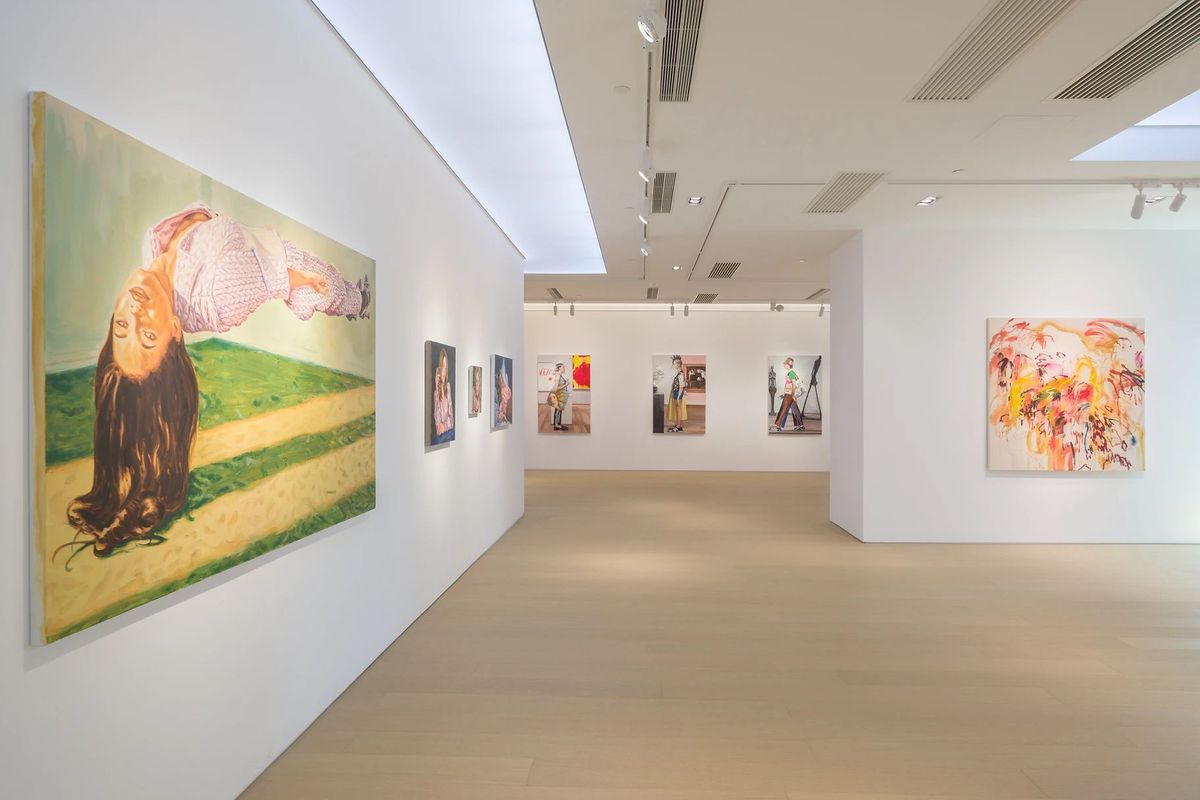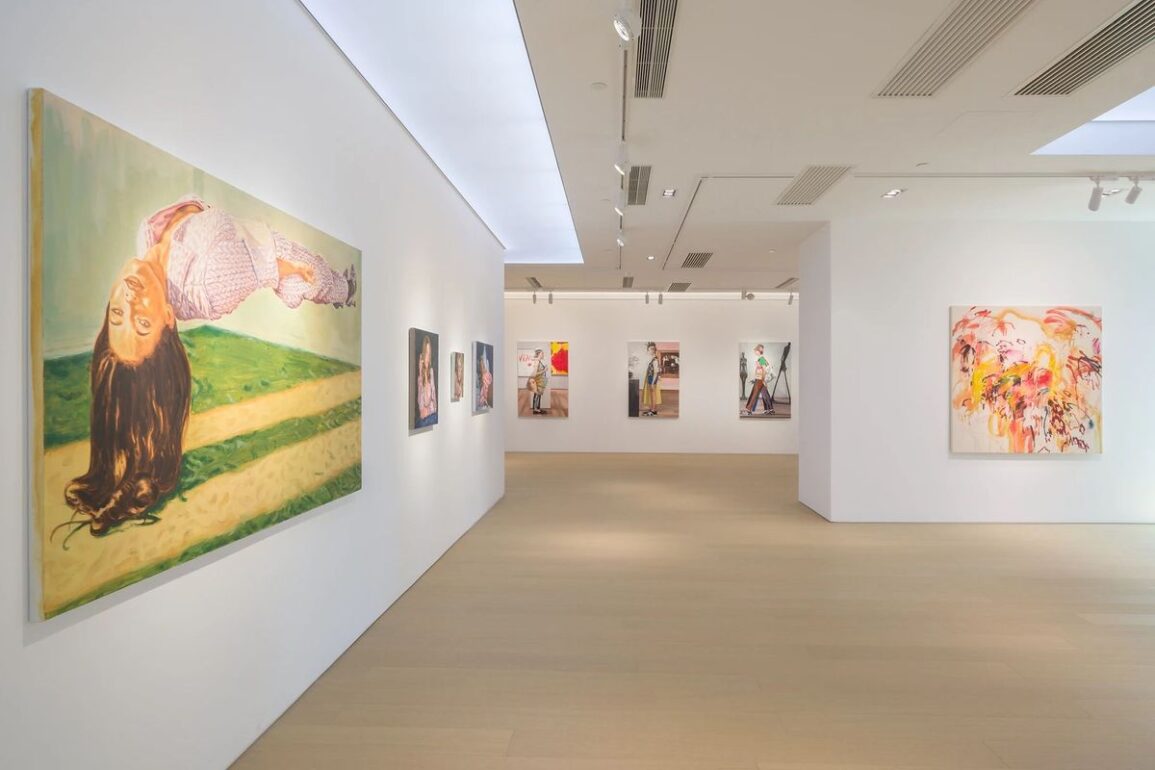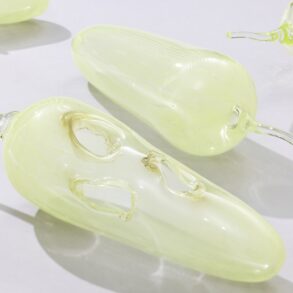
Tales of Women showcases diverse artists, each delving into the complex nature of femininity across different cultures and mediums. This exhibition honours women as complete beings, not merely as male counterparts.
Rose Barberat (b. 1994, Saint-Claude) utilises colour to create an immersive and experiential impact. Her work delves into contemporary issues of representation, drawing inspiration from French painters like Jacques Monory of the narrative figuration movement. Barberat’s art invites viewers to see painting as a bridge to cinema, fiction, and storytelling. Her paintings portray contemporary dystopias, offering multiple readings and interpretations.
Nianxin Li (b. 1999, Chongqing)’s paintings explore the body as sensual architecture, where soft organisms transform into otherness, beautifully capturing feminine intimacy and fragility. These precariously balanced creatures evoke a sense of delicate vulnerability, underscored by the tension present in their compositions. The saturated shades of colour that permeate Li’s canvases heighten this emotional intensity, reflecting the nuanced and fragile nature of intimate feminine experiences.
Alexander Skats (b. 1986, Gothenburg) delves into the concept of feminine bodies, capturing movie-like moments that evoke solitude and nostalgia. Skats portrays daily scenes that transform into intricate narratives, reflecting the complexity and ambiguity of feminine experiences. His work suggests a blend of reality and fiction, leading to a confusion of information that invites viewers to explore more profound layers of meaning and emotion.
Okokume (b. 1985, Barcelona)’s celestial alter-ego, Cosmic Girl, gazes back at the viewer with a hopeful expression, inviting reflection on the environment around her. Influenced by Japanese manga, American street culture, and cartoons, the dreamy Cosmic Girl features sparkling eyes, turquoise skin, and pink hair. Created by Okokume in 2015 to raise awareness of environmental issues, Cosmic Girl and her world embody the artist’s deep aspirations for a bright and hopeful future.
With a deep appreciation for the Old Master paintings, Shiqing Deng (b. 1992, Shaanxi) infuses her classical training with a contemporary aesthetic, challenging the historic male gaze in art history. In a post-feminist society, Deng’s work empowers women to gaze back, redefining their presence in art. She uses clothing as a starting point to explore the relationship between virtually-manipulated realities and the tangible world. The human body is the carrier of clothing, and clothing becomes a medium for bodily expression. In her paintings, cloth, and figure intertwine, representing a second skin that transcends gender, race, and origin, thereby celebrating the fluidity and diversity of human identity.
On the other hand, Celia Lees (b. 1996, Ontario) ‘s abstract paintings pulsate with a vibrant, feminine energy, embodying the fluidity and depth of emotional experience. Her dynamic use of colour and expressive brushstrokes evoke a sense of constant movement, capturing the essence of femininity in its most primal form—sensual, intuitive, and powerful. Lees draws upon memories and emotions, weaving them into her work to reflect the female experience, where past and present intertwine with the forms and figures that inhabit her world. Her creative process, which blends rhythmic, musical gestures with uninhibited physical expression, mirrors the inherent strength and grace of feminine energy. As an Abstract artist, Lees uses her gestural language to communicate the complexities of emotion, inviting a broader audience to connect with the universal power of femininity.
With its blend of diverse objects and materials, Gabriel Rico (b. 1980, Lagos de Moreno)’s work powerfully reflects the connection between humans and nature, aligning closely with the themes of “Tales of Women.” Combining organic and synthetic elements with personal artifacts, Rico’s art mirrors the exploration of women’s varied experiences and identities in contemporary art. His ability to bring together seemingly unrelated elements into unified pieces enhances the exhibition’s focus on the complex and sometimes contradictory nature of femininity.
Through his use of natural materials, Rico highlights the strength and resilience inherent in feminine power, much like the artists in “Tales of Women” who explore the many facets of womanhood.
Tales of Women invites viewers to explore diverse portrayals of women in the modern world plagued by eternal struggles: some embody a serene stillness, while others carry restless burdens. The exhibition’s title, “Tales of Women,” also hints at an open interpretation – each painting is a clue to a narrative that each artist has the key to but that we can witness by subtly peering through. They’re left ajar, and we peek at scenes that often strike an impression of our own. Through their work, these artists navigate the boundaries of female identity, adeptly conveying women’s deep-seated desires and hopes.
Press release courtesy Tang Contemporary Art.
This post was originally published on this site be sure to check out more of their content








